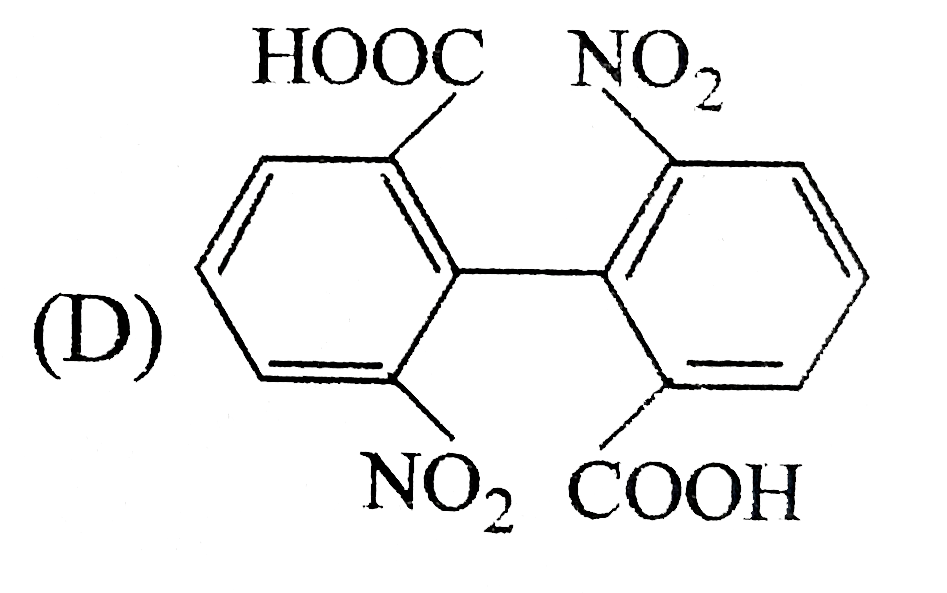Which of the following compound may be optical active ?
All of these
The correct Answer is:A
To determine which of the given compounds may be optically active, we need to understand the concept of optical activity and the structural requirements for a compound to exhibit this property.
1. Understand Optical Activity:
- Optical activity is the ability of a compound to rotate the plane of polarized light. A compound is optically active if it lacks an internal plane of symmetry and is chiral.
2. Identify the Types of Ligands:
- In coordination compounds, ligands can be monodentate (bind through one donor atom) or bidentate (bind through two donor atoms). Bidentate ligands can create chelate rings, which may lead to chirality.
3. Analyze the Given Complexes:
- The question mentions complexes of the type MAA B2 and MABCD.
- MAA B2 indicates a metal (M) coordinated to a bidentate ligand (AA) and two monodentate ligands (B).
- MABCD indicates a metal (M) coordinated to four different ligands (A, B, C, D).
4. Determine Chirality:
- For the MAA B2 complex, if the arrangement of ligands leads to a non-superimposable mirror image, it can be optically active.
- For the MABCD complex, since all four ligands are different, it is likely to be chiral and thus optically active.
5. Conclusion:
- Based on the analysis, both types of complexes (MAA B2 and MABCD) can exhibit optical activity depending on their specific arrangements. Therefore, all three options mentioned in the question may be optically active.
Final Answer:
All three compounds (from the types MAA B2 and MABCD) may be optically active.
---
- Optical activity is the ability of a compound to rotate the plane of polarized light. A compound is optically active if it lacks an internal plane of symmetry and is chiral.
- In coordination compounds, ligands can be monodentate (bind through one donor atom) or bidentate (bind through two donor atoms). Bidentate ligands can create chelate rings, which may lead to chirality.
- The question mentions complexes of the type MAA B2 and MABCD.
- MAA B2 indicates a metal (M) coordinated to a bidentate ligand (AA) and two monodentate ligands (B).
- MABCD indicates a metal (M) coordinated to four different ligands (A, B, C, D).
- For the MAA B2 complex, if the arrangement of ligands leads to a non-superimposable mirror image, it can be optically active.
- For the MABCD complex, since all four ligands are different, it is likely to be chiral and thus optically active.
- Based on the analysis, both types of complexes (MAA B2 and MABCD) can exhibit optical activity depending on their specific arrangements. Therefore, all three options mentioned in the question may be optically active.
All three compounds (from the types MAA B2 and MABCD) may be optically active.
Topper's Solved these Questions
- BOOK - AAKASH INSTITUTECHAPTER - COORDINATION COMPOUNDS EXERCISE - Assignment (Section-I Subjective Type Questions )10videos
COORDINATION COMPOUNDS
- BOOK - AAKASH INSTITUTECHAPTER - CLASSIFICATION OF ELEMENTS AND PERIODICITY IN PROPERTIESEXERCISE - Assignment (Section - J Aakash Challengers Questions)6videos
CLASSIFICATION OF ELEMENTS AND PERIODICITY IN PROPERTIES
- BOOK - AAKASH INSTITUTECHAPTER - ELECTROCHEMISTRY EXERCISE - Assignment (SECTION - J) (Aakash Challengers Questions)10videos
ELECTROCHEMISTRY
Similar Questions
Knowledge Check
- Question 1 - Select One or More
Which of the following compounds are optically active ?
A(A) CH3.CHOH.CH2.CH3B(B) H2C=CH.CH2.CH=CH2C D
D
- Question 2 - Select One
Which of the following compound s is optically active ?
A1-butanolBEthanolC2-butanolDlsopropyl alcohol - Question 3 - Select One
Which of the following compounds is optically active?
ACH3−CH2−CH2OHB CCH3CH∣ClCH3DCH3−CH2−CH3
CCH3CH∣ClCH3DCH3−CH2−CH3
Which of the following compounds is optically active ?
View SolutionWhich of the following compounds is optically active ?
View SolutionWhich of the following compounds is optically active ?
View SolutionWhich of the following compounds is optically active ?
View SolutionWhich of the following compounds is optically active ?
View Solution

